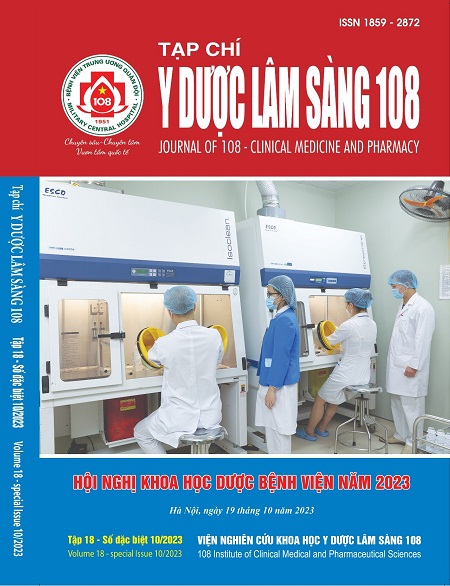Khảo sát việc sử dụng kháng sinh amikacin tại các Khoa Hồi sức tích cực, Bệnh viện Trung ương Quân đội 108
Main Article Content
Keywords
Tóm tắt
Mục tiêu: (1) Khảo sát đặc điểm các chủng vi khuẩn phân lập được trong mẫu nghiên cứu và (2) Khảo sát đặc điểm sử dụng amikacin và độc tính trên thận của thuốc. Đối tượng và phương pháp: Nghiên cứu cắt ngang mô tả được tiến hành tại các khoa Hồi sức tích cực Bệnh viện Trung ương Quân đội 108. Dữ liệu được phân tích từ hồ sơ bệnh án của bệnh nhân sử dụng amikacin từ ngày 01/01/2022 đến ngayf 31/5/2022. Kết quả: Mẫu nghiên cứu bao gồm 120 bệnh nhân, trung vị độ tuổi của bệnh nhân là 74 tuổi. Có 76 (63,3%) bệnh nhân sử dụng chế độ liều 1 lần/ngày (ODD) với liều nạp trung bình là 12,1 ± 2,8 mg/kg. Có 16 (13,3%) bệnh nhân xuất hiện độc tính trên thận và 3 bệnh nhân trong số đó có chỉ định lọc máu sau đó. Kết luận: Chế độ liều amikacin tại các khoa hồi sức tích cực còn thấp hơn so với các hướng dẫn. Amikacin là thuốc có khoảng điều trị hẹp, cần giám sát nồng độ trong máu (TDM) và hiệu chỉnh liều cho phù hợp theo trị số nồng độ đo được.
Article Details
Các tài liệu tham khảo
2. Bệnh viện Trung ương Quân đội 108 (2021) Báo cáo tình hình vi khuẩn đề kháng kháng sinh năm 2021.
3. Taccone FS, Laterre PF, Spapen H et al (2010) Revisiting the loading dose of amikacin for patients with severe sepsis and septic shock. Critical Care 14(2).
4. Rodvold KA, George JM, Yoo L (2011) Penetration of antiinfective agents into pulmonary epithelial lining fluid: focus on antibacterial agents. Clin Pharmacokinet 50(10): 637-664.
5. Roberts JA, Abdul-Aziz MH, Lipman J et al (2014), Individualised antibiotic dosing for patients who are critically ill: Challenges and potential solutions. The Lancet Infectious Diseases 14(6): 498-509.
6. Vincent JL, Rello J, Marshall J et al (2009) International study of the prevalence and outcomes of infection in intensive care units. JAMA 302(21): 2323-2329.
7. Bassetti M, Luyt CE, Nicolau DP et al (2016) Characteristics of an ideal nebulized antibiotic for the treatment of pneumonia in the intubated patient. Annals of Intensive Care 6(1): 35-35.
8. Kalil AC, Metersky ML, Klompas M et al (2016) Management of adults with hospital-acquired and ventilator-associated pneumonia: 2016 clinical practice guidelines by the infectious diseases society of America and the american thoracic society. Clin Infect Dis 63(5): 61-111.
9. Niederman MS, Alder J, Bassetti M et al (2020) Inhaled amikacin adjunctive to intravenous standard-of-care antibiotics in mechanically ventilated patients with gram-negative pneumonia (INHALE): A double-blind, randomised, placebocontrolled, phase 3, superiority trial. The Lancet Infectious Diseases 20(3): 330-340.
10. Craig WA (2011) Optimizing aminoglycoside use. Crit Care Clin 27(1): 107-121.
11. Leggett JE (2015) Aminoglycosides. In: Bennett JE, Dolin R, Blaser MJ (Eds.) Mandell, Douglas, and Bennett's Principles and Practice of Infectious Diseases 8: 310-321.
12. Duszynska W, Taccone FS, Hurkacz M et al (2013) Therapeutic drug monitoring of amikacin in septic patients. Critical Care 17.
13. Oliveira JF, Silva CA, Barbieri CD et al (2009) Prevalence and risk factors for aminoglycoside nephrotoxicity in intensive care units. Antimicrob Agents Chemother 53(7): 2887-2891.
 ISSN: 1859 - 2872
ISSN: 1859 - 2872
